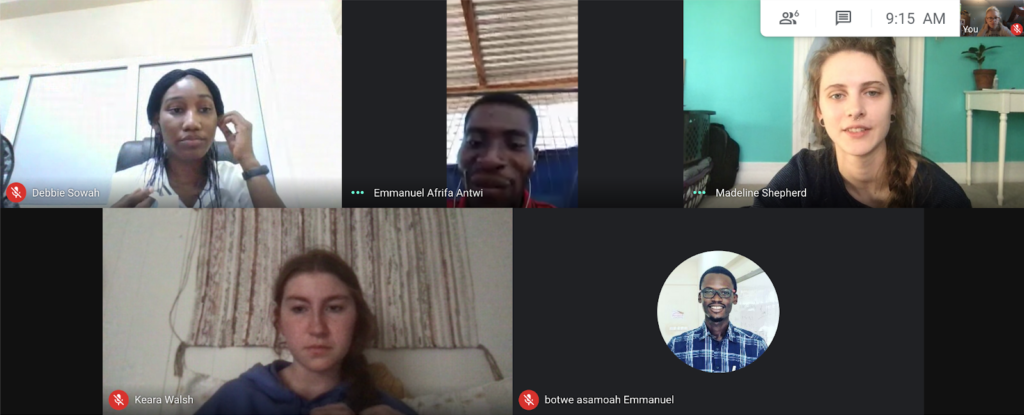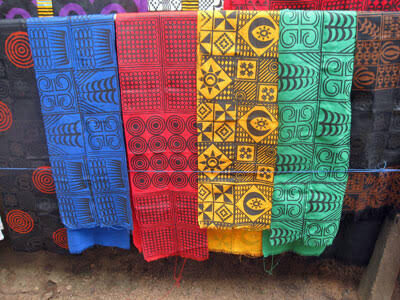
Design for Generative Justice class during the Winter 2021 semester
As an aspiring product designer with an interest in the medical field, Katja Ampe hopes her creations will someday make a positive impact in people’s lives. But she has some reservations about how they might be manufactured.
“I could be responsible for lots of things getting made in factories and using up resources,” said Katja, a rising sophomore at the University of Michigan Stamps School of Art & Design. “You’ve got the product you’re designing that can help people, but then there’s the whole making it. How is that affecting people?”
Finding that balance between ingenuity and sustainability led Ampe to professor Ron Eglash‘s Design for Generative Justice class during the Winter 2021 semester, where she and her classmates worked closely with artisans and entrepreneurs in Kumasi, Ghana. Together, the group explored what it means to build—and keep—value in a community. Students in the course also shared computer coding skills with Ghanese students and helped launch a retail website for makers celebrating their African heritage in Ghana and Detroit through fashion and product design.
The class and the projects related to it demonstrate Eglash’s work around “generative justice,” an alternative economic theory he developed that keeps value in unalienated forms at the grassroots, and circulates it rather than extracts it—a process he maintains is already happening with the rise of makerspaces, urban agriculture and the “artisanal economy.”

“While the idea of a circular economy is common for environmental value, there is often little attention paid to labor and social value,” said Eglash, who is a professor at Stamps and the U-M School of Information. “The goal of the class is for students to explore what it might mean to allow all of those elements to cycle value back to the grassroots creatives, whether those are people, plants or other agents of generativity.”
Citing the record-breaking financial success of 2018 Afrofuturist superhero film Black Panther as an example, Eglash hopes to see new ways to sustainably empower local makers to take control of their own heritage materials.
“That’s great to see a new vision of Africa, but the film made $1.3 billion in the first month, and we know that profit was not going to the villages and communities that created those traditions. Why should the Disney corporation be the world’s largest recipient of wealth from Africa’s cultural capital?” he asked.
Coding African heritage
Eglash first connected with the Creativity Group collective of artists and entrepreneurs in Ghana about nine years ago. In 2019, he led a workshop at their hub in Kumasi to demonstrate how his computer simulation software, Culturally Situated Design Tools (CSDTs), co-developed with research partner and fellow Stamps professor Audrey Bennett and funded by the National Science Foundation, could be used in STEM education.
CSTDs encourage students to explore math and computing through “heritage algorithms” that include cornrow braiding fractals, Navajo weaving patterns, Latino percussion ratios and the nonlinear curves of urban graffiti. Through interviews with local textile artisans, Eglash’s team focused on creating simulations and laser cutting textile applications for African designs.
For the Winter 2021 semester, Eglash’s students spent the first part of the term learning about African heritage and collaborating to develop algorithmic computer simulations of different patterns, including Adinkra symbols and cornrow hair braids. During the second half of the semester, students met remotely via Zoom with students from the Jackson Institute in Ghana to share what they had learned.
“By linking computer coding to their own heritage, Ghanaian students were more receptive to learning to code and also thinking about how to apply the concepts to their own lives,” said Deborah Hammond-Sowah, technology officer at the Jackson Institute and former president of the Creativity Group.
“They realized that design is not just pen and pencil, but that you can also code to design.”
As part of their process, U-M students also interviewed local artisans to learn about traditional weaving and dying techniques, including the Adinkra artisans’ process for making dye from tree bark—a tradition that emphasizes the importance of limiting harvests to what trees can regrow, and protecting the forests from agriculture and lumber industries. For Ampe, it was a welcome contrast to Western methods of industrial production.
“It makes this whole cycle of sustainability,” she said.

For Madeline Shepherd, a rising senior at Stamps, another big takeaway from the course was the importance of communication, as she learned to work remotely with students and artists from different cultures.
“I definitely gained a new perspective,” she said. “Design is an important communication tool. You have to understand how someone else is taking in the information that you’re providing.”
Working with Ghanaian textile weavers, Shepherd enjoyed interviewing one of the artisans and learning his perspective on what was possible to produce and what wasn’t when it came to computer-programmed symbols. The short answer: Just about anything is possible.
Although she doesn’t intend to go into coding or software-based design in the future, Shepherd says having that direct connection with makers and close collaboration with her team was a rewarding experience
“It further solidified my desire to work with people and for people,” she said. “The work we were doing felt valuable, because I knew there was an end audience, and in some cases I got to see who that end audience was, which was nice.”
From Ghana, by way of Detroit
For their final project, students worked in groups to help finish a website for the African Futurist Collective of makers, including an online store for AfroFuture Fashions. Led by Hammond-Sowah, AfroFuture Fashions closes the generative loop by offering T-shirts and facemasks featuring Adinkra designs created with CSDT simulations, laser cutting and “old school embroidery” by local artisans, with all proceeds staying local.
“By making the software more relevant to entrepreneurship, we get the students more interested,” Eglash said. “And by linking the shop to education, we hope to make a broader appeal to customers.”

According to Eglash and his students, the ultimate goal of the project was to create a platform equipped to support a whole ecosystem of activities across the African diaspora. Providing e-fulfillment services through a company like Amazon would allow big corporations to extract value, so instead, students connected the artisans to a small Black-owned company in Detroit, Xclusive Hair, to explore new opportunities to keep supply chains local and worker-owned.
Other Detroit companies students worked with included Visual Noise, a textile shop, and Lillian Augusta, which uses invasive plants to create sustainable hair extensions.
“When you look at the range of products, supply needs and services at the grassroots, you start to realize that an entire economy might be possible if we can facilitate flows linking small scale artisanal enterprises,” Eglash said.
Completing the loop
While not everything always ran according to plan while collaborating from 5,500 miles away, figuring out how to make it work is part of preparing for a post-COVID, global workplace.
“There were definitely internet problems and time change differences, but those are all parts of working internationally or virtually,” Ampe said. “Those are also learning processes.”
In addition to product design, she also has an interest in textiles, and she had the opportunity to work with a weaver in Ghana for her final project. Although Ampe was hesitant at first, Hammond-Sowah encouraged her to create her own Kente designs, which could be produced and sold through AfroFuture Fashions.
“That’s part of the reason I came to U-M, for opportunities to just try things that are very new and connect with people who are very different from me,” she said. “A lot of classes have been more academic or abstract, but this was like … you’re actually connecting with people and doing real work, and that was cool.”
By Eric Gallippo


